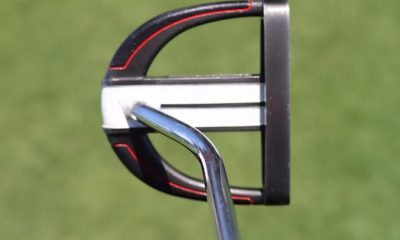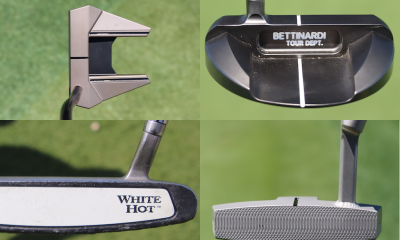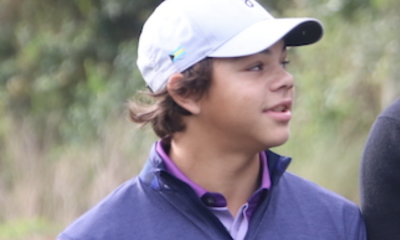Opinion & Analysis
The Wedge Guy: Realistic expectations

(Today’s post is one I actually wrote nearly eight years ago, but I’m using it to start a series about “thinking your way to better golf.” I hope you enjoy the next few weeks.)
One of the great regrets of my life is that I missed the fatherhood experience, never having had children of my own. As I get older, I find that I gravitate to the younger folks, and offer my help whenever I can, whether on the golf course, on the water fishing, or just life in general. One of my joys is working with younger kids on their golf. That includes instruction, of course, but what I think is more important for them in the developmental stages is to learn to manage
their expectations. Actually, we all could benefit from that bit of advice.
On Sunday, I had the joy of playing with the 16-year-old son of one of our partners at SCOR Golf. Kyle is a tremendously talented young man who I’ve worked with quite a bit, but he really hasn’t committed himself to golf yet. I’m talking about the kind of commitment that keeps him working hard at it as long as there is daylight. He might not ever get that, and that’s OK, but he hasn’t figured out yet that your expectations can only rise from your achievements, and not from your desires.
On a core level, Kyle has great strength but hasn’t learned to harness it yet. He wants to choose his clubs based on his maximum distance with that club—if everything falls exactly into place. Like most golfers, and especially young ones,
he’s enamored with the power game. When we play, I show him that throttling back and controlling the shot is much more reliable.
What I discovered Sunday is that Kyle has very unrealistic expectations about what a round of golf should really be like. He, like most of us, expects all the shots to be struck solidly and fly like he imagined. So I explained that he hasn’t
earned the right to have such expectations yet. His scores average around 90-95 and his best ever is an 85.
So, here’s my point (finally)
Kyle was off to a good start with three pars and two bogeys in his first five holes. He kind of “fat-pulled” a 4-iron approach on a 200-plus yard par three. His shot left him only 10-15 yards short and left of the green, but he wheeled around, dropped his club and expressed his disgust with the shot. And I got on him about it. “What’s wrong with that? It’s a difficult par-3 with a 20 mph crosswind and you are in good position to get up and down or at least make no worse than bogey on one of the hardest holes on the course.”
I went on to explain that he was only two pars away from tying his best round ever, and if he just played for bogeys – and stay excited—he would probably make twice that many or more. And I seemed to get through to him of the reality
of golf, or his golf at least. He stayed in the moment, with only a little more cajoling from me, and shot an 86—one shot off his best ever! And I MADE him congratulate himself on his accomplishments. Instead of focusing on those few
shots that were bad, and the 2-3 doubles he made, I told him to focus on the good that came out of that round.
So, here’s my point (or points) for managing your expectations, too.
- If you are a low single-digit player, you’ll still only hit 2-3 shots a round just like you wanted.
- If you play to a 12 or higher, any shot that keeps you in the game isn’t really all that bad.
- Regardless of your skill level, there is no such thing as a “birdie hole” when you are standing on the tee. A “birdie hole” can only be claimed when you have executed an approach to makeable putt range.
- If you are a 12-15 handicap player, you only need to make 3-6 pars to beat your handicap, as long as you don’t chop up any holes. Bogeys are good scores unless you regularly shoot in the 70s!
So, the next time you are on the golf course, try to set and manage realistic expectations. Your golf will be better for it, and you’ll have a ton more fun.
NOTE: I read a great article this morning by Geoff Ogilvy about the quality of golf being played on the PGA Tour. It reflects what I’ve often said about how the modern tour professional plays the game. Here it is.
- LIKE113
- LEGIT15
- WOW2
- LOL0
- IDHT2
- FLOP0
- OB0
- SHANK3
19th Hole
Vincenzi’s 2024 Zurich Classic of New Orleans betting preview

The PGA TOUR heads to New Orleans to play the 2023 Zurich Classic of New Orleans. In a welcome change from the usual stroke play, the Zurich Classic is a team event. On Thursday and Saturday, the teams play best ball, and on Friday and Sunday the teams play alternate shot.
TPC Louisiana is a par 72 that measures 7,425 yards. The course features some short par 4s and plenty of water and bunkers, which makes for a lot of exciting risk/reward scenarios for competitors. Pete Dye designed the course in 2004 specifically for the Zurich Classic, although the event didn’t make its debut until 2007 because of Hurricane Katrina.
Coming off of the Masters and a signature event in consecutive weeks, the field this week is a step down, and understandably so. Many of the world’s top players will be using this time to rest after a busy stretch.
However, there are some interesting teams this season with some stars making surprise appearances in the team event. Some notable teams include Patrick Cantlay and Xander Schauffele, Rory McIlroy and Shane Lowry, Collin Morikawa and Kurt Kitayama, Will Zalatoris and Sahith Theegala as well as a few Canadian teams, Nick Taylor and Adam Hadwin and Taylor Pendrith and Corey Conners.
Past Winners at TPC Louisiana
- 2023: Riley/Hardy (-30)
- 2022: Cantlay/Schauffele (-29)
- 2021: Leishman/Smith (-20)
- 2019: Palmer/Rahm (-26)
- 2018: Horschel/Piercy (-22)
- 2017: Blixt/Smith (-27)
2024 Zurich Classic of New Orleans Picks
Tom Hoge/Maverick McNealy +2500 (DraftKings)
Tom Hoge is coming off of a solid T18 finish at the RBC Heritage and finished T13 at last year’s Zurich Classic alongside Harris English.
This season, Hoge is having one of his best years on Tour in terms of Strokes Gained: Approach. In his last 24 rounds, the only player to top him on the category is Scottie Scheffler. Hoge has been solid on Pete Dye designs, ranking 28th in the field over his past 36 rounds.
McNealy is also having a solid season. He’s finished T6 at the Waste Management Phoenix Open and T9 at the PLAYERS Championship. He recently started working with world renowned swing coach, Butch Harmon, and its seemingly paid dividends in 2024.
Keith Mitchell/Joel Dahmen +4000 (DraftKings)
Keith Mitchell is having a fantastic season, finishing in the top-20 of five of his past seven starts on Tour. Most recently, Mitchell finished T14 at the Valero Texas Open and gained a whopping 6.0 strokes off the tee. He finished 6th at last year’s Zurich Classic.
Joel Dahmen is having a resurgent year and has been dialed in with his irons. He also has a T11 finish at the PLAYERS Championship at TPC Sawgrass which is another Pete Dye track. With Mitchell’s length and Dahmen’s ability to put it close with his short irons, the Mitchell/Dahmen combination will be dangerous this week.
Taylor Moore/Matt NeSmith +6500 (DraftKings)
Taylor Moore has quickly developed into one of the more consistent players on Tour. He’s finished in the top-20 in three of his past four starts, including a very impressive showing at The Masters, finishing T20. He’s also finished T4 at this event in consecutive seasons alongside Matt NeSmith.
NeSmith isn’t having a great 2024, but has seemed to elevate his game in this format. He finished T26 at Pete Dye’s TPC Sawgrass, which gives the 30-year-old something to build off of. NeSmith is also a great putter on Bermudagrass, which could help elevate Moore’s ball striking prowess.
- LIKE8
- LEGIT3
- WOW1
- LOL1
- IDHT0
- FLOP3
- OB1
- SHANK2
19th Hole
Vincenzi’s 2024 LIV Adelaide betting preview: Cam Smith ready for big week down under

After having four of the top twelve players on the leaderboard at The Masters, LIV Golf is set for their fifth event of the season: LIV Adelaide.
For both LIV fans and golf fans in Australia, LIV Adelaide is one of the most anticipated events of the year. With 35,000 people expected to attend each day of the tournament, the Grange Golf Club will be crawling with fans who are passionate about the sport of golf. The 12th hole, better known as “the watering hole”, is sure to have the rowdiest of the fans cheering after a long day of drinking some Leishman Lager.
The Grange Golf Club is a par-72 that measures 6,946 yards. The course features minimal resistance, as golfers went extremely low last season. In 2023, Talor Gooch shot consecutive rounds of 62 on Thursday and Friday, giving himself a gigantic cushion heading into championship Sunday. Things got tight for a while, but in the end, the Oklahoma State product was able to hold off The Crushers’ Anirban Lahiri for a three-shot victory.
The Four Aces won the team competition with the Range Goats finishing second.
*All Images Courtesy of LIV Golf*
Past Winners at LIV Adelaide
- 2023: Talor Gooch (-19)
Stat Leaders Through LIV Miami
Green in Regulation
- Richard Bland
- Jon Rahm
- Paul Casey
Fairways Hit
- Abraham Ancer
- Graeme McDowell
- Henrik Stenson
Driving Distance
- Bryson DeChambeau
- Joaquin Niemann
- Dean Burmester
Putting
- Cameron Smith
- Louis Oosthuizen
- Matt Jones
2024 LIV Adelaide Picks
Cameron Smith +1400 (DraftKings)
When I pulled up the odds for LIV Adelaide, I was more than a little surprised to see multiple golfers listed ahead of Cameron Smith on the betting board. A few starts ago, Cam finished runner-up at LIV Hong Kong, which is a golf course that absolutely suits his eye. Augusta National in another course that Smith could roll out of bed and finish in the top-ten at, and he did so two weeks ago at The Masters, finishing T6.
At Augusta, he gained strokes on the field on approach, off the tee (slightly), and of course, around the green and putting. Smith able to get in the mix at a major championship despite coming into the week feeling under the weather tells me that his game is once again rounding into form.
The Grange Golf Club is another course that undoubtedly suits the Australian. Smith is obviously incredibly comfortable playing in front of the Aussie faithful and has won three Australian PGA Championship’s. The course is very short and will allow Smith to play conservative off the tee, mitigating his most glaring weakness. With birdies available all over the golf course, there’s a chance the event turns into a putting contest, and there’s no one on the planet I’d rather have in one of those than Cam Smith.

Louis Oosthuizen +2200 (DraftKings)
Louis Oosthuizen has simply been one of the best players on LIV in the 2024 seas0n. The South African has finished in the top-10 on the LIV leaderboard in three of his five starts, with his best coming in Jeddah, where he finished T2. Perhaps more impressively, Oosthuizen finished T7 at LIV Miami, which took place at Doral’s “Blue Monster”, an absolutely massive golf course. Given that Louis is on the shorter side in terms of distance off the tee, his ability to play well in Miami shows how dialed he is with the irons this season.
In addition to the LIV finishes, Oosthuizen won back-to-back starts on the DP World Tour in December at the Alfred Dunhill Championship and the Mauritus Open. He also finished runner-up at the end of February in the International Series Oman. The 41-year-old has been one of the most consistent performers of 2024, regardless of tour.
For the season, Louis ranks 4th on LIV in birdies made, T9 in fairways hit and first in putting. He ranks 32nd in driving distance, but that won’t be an issue at this short course. Last season, he finished T11 at the event, but was in decent position going into the final round but fell back after shooting 70 while the rest of the field went low. This season, Oosthuizen comes into the event in peak form, and the course should be a perfect fit for his smooth swing and hot putter this week.

- LIKE12
- LEGIT3
- WOW1
- LOL1
- IDHT0
- FLOP1
- OB1
- SHANK1
Opinion & Analysis
The Wedge Guy: What really makes a wedge work? Part 1

Of all the clubs in our bags, wedges are almost always the simplest in construction and, therefore, the easiest to analyze what might make one work differently from another if you know what to look for.
Wedges are a lot less mysterious than drivers, of course, as the major brands are working with a lot of “pixie dust” inside these modern marvels. That’s carrying over more to irons now, with so many new models featuring internal multi-material technologies, and almost all of them having a “badge” or insert in the back to allow more complex graphics while hiding the actual distribution of mass.
But when it comes to wedges, most on the market today are still single pieces of molded steel, either cast or forged into that shape. So, if you look closely at where the mass is distributed, it’s pretty clear how that wedge is going to perform.
To start, because of their wider soles, the majority of the mass of almost any wedge is along the bottom third of the clubhead. So, the best wedge shots are always those hit between the 2nd and 5th grooves so that more mass is directly behind that impact. Elite tour professionals practice incessantly to learn to do that consistently, wearing out a spot about the size of a penny right there. If impact moves higher than that, the face is dramatically thinner, so smash factor is compromised significantly, which reduces the overall distance the ball will fly.
Every one of us, tour players included, knows that maddening shot that we feel a bit high on the face and it doesn’t go anywhere, it’s not your fault.
If your wedges show a wear pattern the size of a silver dollar, and centered above the 3rd or 4th groove, you are not getting anywhere near the same performance from shot to shot. Robot testing proves impact even two to three grooves higher in the face can cause distance loss of up to 35 to 55 feet with modern ‘tour design’ wedges.
In addition, as impact moves above the center of mass, the golf club principle of gear effect causes the ball to fly higher with less spin. Think of modern drivers for a minute. The “holy grail” of driving is high launch and low spin, and the driver engineers are pulling out all stops to get the mass as low in the clubhead as possible to optimize this combination.
Where is all the mass in your wedges? Low. So, disregarding the higher lofts, wedges “want” to launch the ball high with low spin – exactly the opposite of what good wedge play requires penetrating ball flight with high spin.
While almost all major brand wedges have begun putting a tiny bit more thickness in the top portion of the clubhead, conventional and modern ‘tour design’ wedges perform pretty much like they always have. Elite players learn to hit those crisp, spinny penetrating wedge shots by spending lots of practice time learning to consistently make contact low in the face.
So, what about grooves and face texture?
Grooves on any club can only do so much, and no one has any material advantage here. The USGA tightly defines what we manufacturers can do with grooves and face texture, and modern manufacturing techniques allow all of us to push those limits ever closer. And we all do. End of story.
Then there’s the topic of bounce and grinds, the most complex and confusing part of the wedge formula. Many top brands offer a complex array of sole configurations, all of them admittedly specialized to a particular kind of lie or turf conditions, and/or a particular divot pattern.
But if you don’t play the same turf all the time, and make the same size divot on every swing, how would you ever figure this out?
The only way is to take any wedge you are considering and play it a few rounds, hitting all the shots you face and observing the results. There’s simply no other way.
So, hopefully this will inspire a lively conversation in our comments section, and I’ll chime in to answer any questions you might have.
And next week, I’ll dive into the rest of the wedge formula. Yes, shafts, grips and specifications are essential, too.
- LIKE34
- LEGIT7
- WOW1
- LOL1
- IDHT2
- FLOP3
- OB1
- SHANK3
-

 19th Hole2 weeks ago
19th Hole2 weeks agoDave Portnoy places monstrous outright bet for the 2024 Masters
-

 19th Hole4 days ago
19th Hole4 days agoJustin Thomas on the equipment choice of Scottie Scheffler that he thinks is ‘weird’
-

 19th Hole2 weeks ago
19th Hole2 weeks agoTiger Woods arrives at 2024 Masters equipped with a putter that may surprise you
-

 19th Hole3 days ago
19th Hole3 days ago‘Absolutely crazy’ – Major champ lays into Patrick Cantlay over his decision on final hole of RBC Heritage
-

 19th Hole2 weeks ago
19th Hole2 weeks agoTwo star names reportedly blanked Jon Rahm all week at the Masters
-

 19th Hole1 week ago
19th Hole1 week agoReport: LIV Golf identifies latest star name they hope to sign to breakaway tour
-

 19th Hole2 weeks ago
19th Hole2 weeks agoNeal Shipley presser ends in awkward fashion after reporter claims Tiger handed him note on 8th fairway
-

 19th Hole1 week ago
19th Hole1 week agoBrandel Chamblee has ‘no doubt’ who started the McIlroy/LIV rumor and why
























myron miller
Feb 26, 2020 at 2:09 pm
I disagree with his idea of a birdie hole. To me, a birdie hole is one that I can reasonably expect if i hit the ball decently have a reasonable chance of birdie. Hell, there are times that I’ve hit miraculus shots that went totally unrealistic distances and hit near the hole eventually for a birdie, where normally I have no chance of getting anywhere near a birdie. My normal chances on some holes, is slightly greater than 0 say 1% (1 in 10,000 or less. But a hole where I can if i do everything ok, have a realistic putt (within 20 feet) at a birdie to me is a birdiable hole (birdie hole). I approach the hole with the idea that I can birdie the hole if I hit each shot reasonably and can reach the green or very close (within 20 yards) in regulation. Those holes that I have zero chance of reaching in regulation (like a par 3 of 200+ yards or a 575 yard par 5.
His idea of any shot that “keeps you in the game” isn’t bad is unclear. What does this actually mean. say I’m on a 400 yard par 4. If I hit the ball only 100 yards off the tee am I still in the game? It can be in the middle of the fairway but I have zero chance of making par and have to hope to make bogey by hitting the next 3+ shots well. More likely, I’ll make double bogey on this hole. Yet there have been a number of times where I was very happy with the way I hit the ball on the hole and only made the “dreaded double bogey”. Wind screaming at 25+ mph with gusts to 30-40mph and swirling, not in a consistent direction.
Joe
Feb 25, 2020 at 10:56 pm
This is something I need to keep in mind too. I’ve found that when I’ve thought positively, I’ve played better.
iutodd
Feb 25, 2020 at 4:13 pm
I really enjoy all your articles. This whole concept is something that I have to remind myself of a lot. I’m, oh, an 8-10 handicap and when I play as a single I’m usually the “better” player of whomever I get grouped up with. But that still means on average I’ll miss 9-11 greens a round and about half of my fairways! I try to keep high expectations – but I do have to manage those expectations when shots don’t do what I want them to do. I’m also very time constrained and barely/rarely warm up – in fact I don’t really even know what a proper “warm up” feels like. So I generally start off slow, then I play really well from holes 5-13, then I get tired or lose focus. This leaves out entirely the inclusion or exclusion of beer.
I played with what had to be a sub-3 handicapper or better late last year – I was mostly blown away by their focus. I play a lot as a single and often I end up making small talk with the twosome I get paired up with and I end up not focusing all that well and subsequently I don’t play that well. It’s also just hard to be that guy who grinds for 45 seconds over every 3 footer when the other two have beers in their hands. This guy, the low single handicapper, was playing his game and focusing on what he needed to do – it was really impressive to see right up close like that.
I’m not as good as he is – but I aspire to golf like he does. I think managing expectations is totally a part of that because it does break your focus and your confidence and make the game less fun.
Brandon
Feb 25, 2020 at 11:32 am
This is good advice except for the part about club selection. Why would you take more club because you are expecting to hit a bad shot? Seems like you are setting yourself up to fail before you even make the swing. I’d rather be short on most approach shots than long anyway.
Alex
Feb 25, 2020 at 3:48 pm
I dont think you understood the point. What he was saying is that the kid was choosing his club based on max yardage instead of a controlled shot. I.e., hitting a 7i you can take to 175 1 out of 10 shots, instead of taking a smooth 6i to hit the number with an avg shot. I dove down into the low single digits after going off this mentality, taking the stronger club and swinging at ~80% gives way better results than full swings with all clubs.